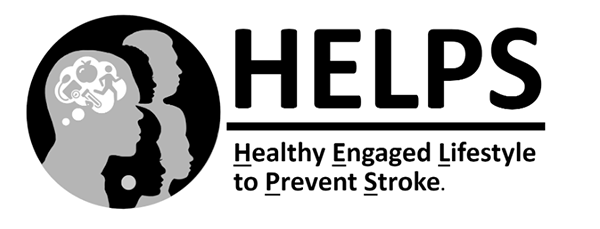
Welcome to the HELPS website. You can use this website to learn about stroke and key risk factors for stroke in three modules: Blood Pressure, Blood Sugar, and Blood Cholesterol. You can also explore healthy habits to reduce the risk of stroke and connect with community resources.
Start learning about stroke below. At the bottom of this page, there will be a link to guide you to the risk factor modules, starting with Blood Pressure.
What is a stroke?
A stroke happens when blood flow to the brain is blocked by a clot or by a blood vessel bursting. As a result, cells in the brain begin to die. (American Stroke Association, n.d.a.)
What are warning signs of a stroke?
Think “FAST”. If you or someone you know experiences any of the following, call 911 immediately:
- F = Face drooping
- A = Arm weakness
- S = Speech difficulty (slurred speech)
- T = Time to call 911
Other signs of a stroke can be:
- Sudden numbness or weakness on one side of the body (face, arm, or leg)
- Sudden confusion, trouble understanding, or having a hard time speaking
- Sudden trouble seeing in one or both eyes
- Sudden trouble walking, being dizzy, or losing balance
- Sudden severe headache without a known reason
(American Stroke Association, n.d.b.)
What are the risk factors for stroke?
“Risk factors” are conditions that increase your chances of a disease happening. There are several risk factors for stroke. You can control some of the risk factors, and others are not under your control.
Learn more about stroke risk
Risk factors you have some control over (or you can do things to manage)
Risk factors you have some control over (or you can do things to manage)
- High blood pressure
- High blood sugar (diabetes)
- High cholesterol levels
- Diet
- Physical inactivity
- Obesity
- Smoking
- Excessive alcohol intake
- Illegal drug use
- Sleep apnea
- Irregular heartbeat
- Sickle cell disease
Risk factors NOT within your control
Risk factors NOT within your control
- Age
- Family history of stroke in the immediate family
- Race and ethnicity
- Prior stroke
- Prior transient ischemic attack (TIA or mini-stroke)
In addition to the risk factors above, community members we talked to identified that stress can make it more difficult to manage risk factors. Managing stress can help you be successful in making healthy lifestyle changes.
Learn more about how to reduce your risk for stroke through three modules: Blood Pressure, Blood Sugar, and Blood Cholesterol.
What is the HELPS study?
The Healthy Engaged Lifestyle to Prevent Stroke (HELPS) Research Study is a community health project to build relationships and engage the Twin Cities African American community around stroke prevention and awareness.
The first phase of the project helped us understand community members' perspectives about stroke and stroke risk factors.
The second phase of the project partners with community members to increase knowledge of stroke risk factors and empower lifestyle changes to prevent stroke.
This project is a collaboration between community members, the University of Minnesota and Hue-MAN Partnership, a community organization.
Read more about the takeaways from the first phase of HELPS.
HELPS Study Team

References
American Stroke Association (n.d.a.). About stroke. https://www.stroke.org/en/about-stroke
American Stroke Association (n.d.b.). Stroke symptoms. https://www.stroke.org/en/about-stroke/stroke-symptoms
American Stroke Association (2021). Stroke risk factors not within your control. https://www.stroke.org/en/about-stroke/stroke-risk-factors/stroke-risk-factors-not-within-your-control
American Stroke Association (2021). Stroke risk factors under your control. https://www.stroke.org/en/about-stroke/stroke-risk-factors/risk-factors-under-your-control
